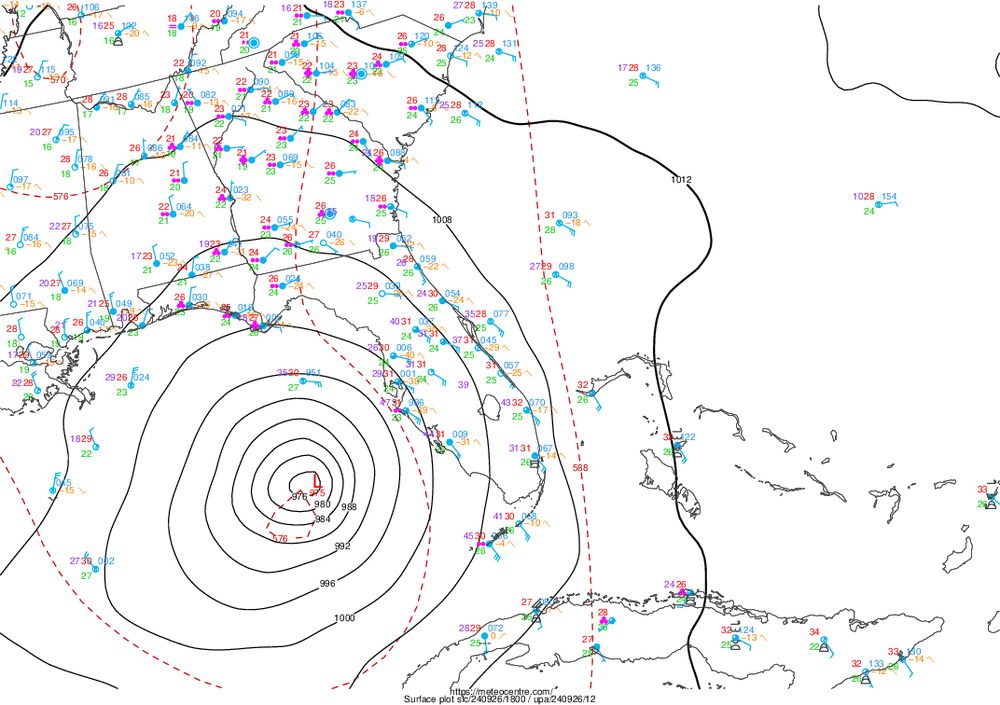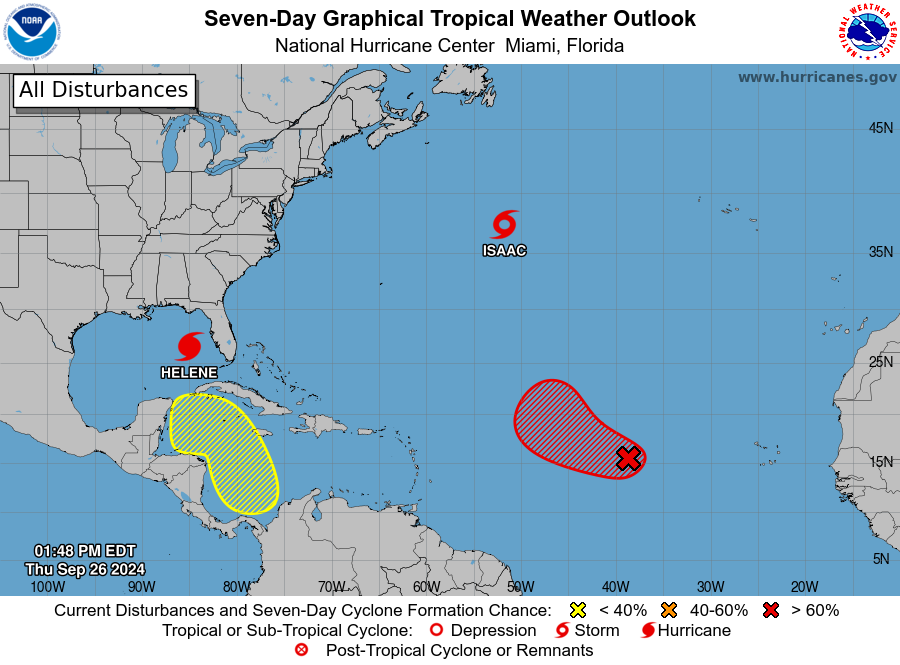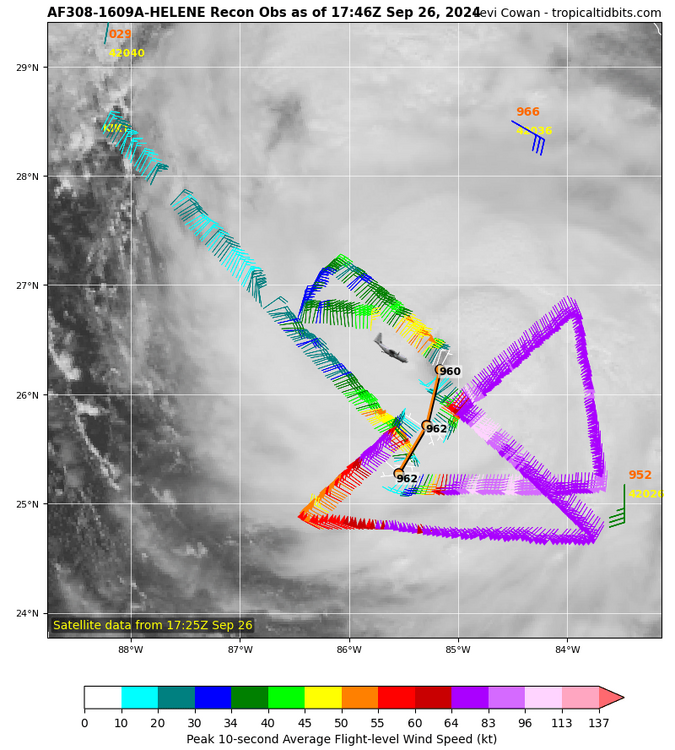-
Posts
3,336 -
Joined
-
Last visited
Content Type
Profiles
Blogs
Forums
American Weather
Media Demo
Store
Gallery
Everything posted by wthrmn654
-
As of 09/26/2024 17:00 EDT, water levels along the Florida Gulf Coast are elevated and continuing to rise as Hurricane Helene approaches. Below is a breakdown of water level observations above normal tide levels by region: Pensacola, FL to Apalachicola, FL.... 1.6 to 3.5 feet Apalachicola, FL to Tampa Bay, FL....3.5 to 3.9 feet Tampa Bay, FL to Key West, FL......1.6 to 3.7 feet Winds along the south and southeastern Florida coast from Key West to Lake Worth Pier presently range between 25 and 35 knots with gusts to 40 knots. Winds from Key West to Cedar Key range between 25 and 40 knots with gusts to 50 knots. Winds along the Florida Panhandle from Pensacola to Apalachicola range between 10 and 15 knots with gusts to 20 knots.
-
I assumed that, but I only see 20 foot seas so maybe I'm missing something
-
31? Which buoy is that by chance the one that's less then 31 miles away is showing 20 feet now
-
Buoy nearing the eye pressure is now dropping fast, -0.35 inches currently at 985.4mb sustained windabout 40 knots gusts nearly 60 knots. Wave height close to 20 feet now.
-
Latest ADT satellite estimate shows 115knot max now which translates to 132mph
-

2024 Atlantic Hurricane Season
wthrmn654 replied to Stormchaserchuck1's topic in Tropical Headquarters
Busy times ahead for all you mets! We thank you all for all the schooling and learned knowledge as well as being patient with us average humans of the USA lol -
I was going say looking at the recon positions of the center and the noaa buoys to the north if would seem instead of going to the right of the buoy is going be going to the left of it instead. But as goose pointed out wobbles and such could make it an unknown variable
-
OK , it was a couple of satellite views of different modes and it's not every 15 mintues.
-
-
Kinda looks like an eye is trying to clear out now
-
Whoever said recon found that low pressure, drop sonde says 952
-
She's getting stronger! Current Analysis ----- Date : 26 SEP 2024 Time : 191020 UTC Lat : 26:49:47 N Lon : 84:44:23 W CI# /Pressure/ Vmax 5.4 / 949.1mb/ 99.6kt Final T# Adj T# Raw T# 5.4 6.3 6.3 Estimated radius of max. wind based on IR :N/A km Center Temp : -8.1C Cloud Region Temp : -70.8C Scene Type : EYE Subtropical Adjustment : OFF Extratropical Adjustment : OFF Positioning Method : ARCHER POSITIONING Ocean Basin : ATLANTIC Dvorak CI > MSLP Conversion Used : CKZ Method Tno/CI Rules : Constraint Limits : NO LIMIT Weakening Flag : OFF Rapid Dissipation Flag : OFF C/K/Z MSLP Estimate Inputs : - Average 34 knot radii : 182nmi - Environmental MSLP : 1007mb Satellite Name : GOES16 Satellite Viewing Angle : 33.0 degrees
-
Things booking now at 20 mph
-
Hurricane Helene Tropical Cyclone Update NWS National Hurricane Center Miami FL AL092024 300 PM EDT Thu Sep 26 2024 ...STORM SURGE AND WINDS INCREASING ALONG THE FLORIDA WEST COAST... ...300 PM EDT POSITION UPDATE... A Weatherflow station at Egmont Channel at the entrance to Tampa Bay recently measured a sustained wind of 50 mph (80 km/h) and a gust to 62 mph (100 km/h). SUMMARY OF 300 PM EDT...1900 UTC...INFORMATION ---------------------------------------------- LOCATION...26.9N 84.8W ABOUT 160 MI...255 KM WSW OF TAMPA FLORIDA ABOUT 195 MI...315 KM S OF APALACHICOLA FLORIDA MAXIMUM SUSTAINED WINDS...120 MPH...195 KM/H PRESENT MOVEMENT...NNE OR 25 DEGREES AT 20 MPH...31 KM/H MINIMUM CENTRAL PRESSURE...959 MB...28.32 INCHES
-
-
About 129nm north waves are at or above 18 feet, winds gusting nearly 65mph. Add insult to injury, high tide is roughly around 100 am , so anyone down there keep in mind that week play a big role in how high tide actually get in all coastal areas
-
Of more shock, if this gets to as strong as several of the hurricane models had showed days ago, and we all were saying there not very good until the system is somewhat more organized, that's impressive for a system that hadn't even gotten a name let alone is core well defined / formed
-
Curious, just was looking at total precipitatable water, that less colored spiral getting wrapped around the western flank, is that anything that would affect weakening/ strengthening at this point? EDIT: just noticed time stamp is a few hours old.
-
This may also go towards what you guys were saying..
-
-
Last thing for a while but, best visual comparison... look at how big that blue wind field line is jeez! https://tidesandcurrents.noaa.gov/inundationdb/?sw=17.49739,-89.05518&ne=34.02535,-78.28857&layers=111111111000
-
16 foot waves already 129NM north at buoy closest to Helene. Pressure already down to 29.40 Current photo of the angry Gulf Link for anyone who wants to track https://www.ndbc.noaa.gov/station_page.php?station=42036
-
As it stands right now, based on the Forcast track, she's going be passing closely 2 buoys out of service in gulf, and since track shifted right, only 1 other station active in the Gulf well be nearby her. If she shifts west, there's able 4 buoys that we can use but it's quite offshore. There's 1 or 2 buoys/ stations at shore that are also or of order. Hopefully there's some noaa/nws stations near the shore that can give us some good pressure/ wind readings.
-

2024 Atlantic Hurricane Season
wthrmn654 replied to Stormchaserchuck1's topic in Tropical Headquarters
-
Last night, was saying if nothing changed by 8 am, it would be doubtful for big end storm. Recon showing such large area on the eastern side especially 64 knots or even higher That's not the case, she's playing out as models have been hinting, the wind field is ridiculously big, in fact, for comparison, looking at some stats, sandy in 2012 had tropical storm form winds 943 miles wide!.. which is the record holder on the Atlantic side. Helene is about 500ish miles wide, I heard recently but can't confirm. Large storms cause large issues. Fresh water flooding, wind and big storm surge. It's coming so buckle down and stay safe those in the Gulf right now!







